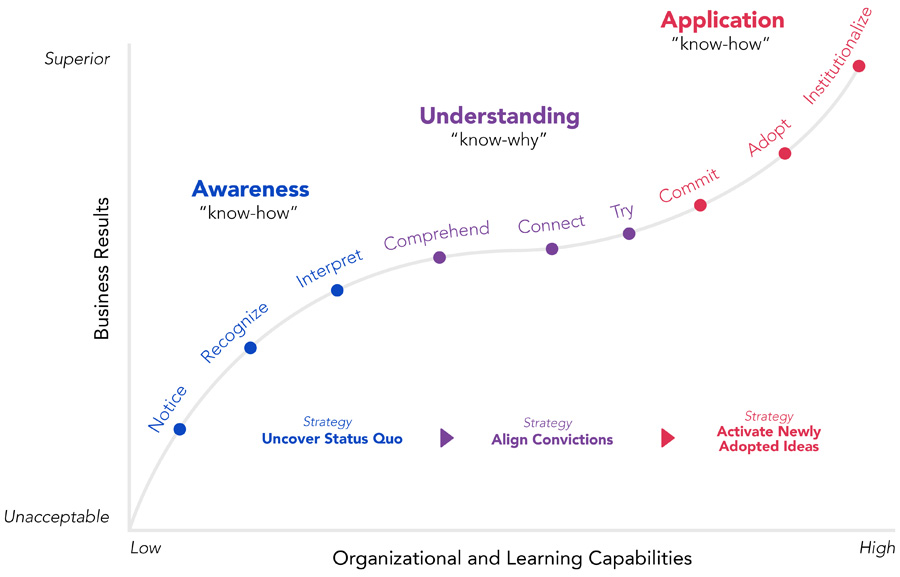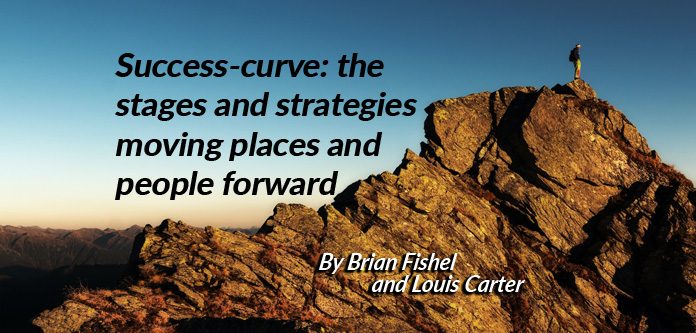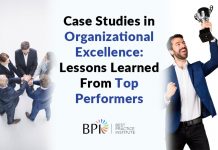Change occurs on two planes. There is the change you have sought and launched. Then, there is the change some call “destiny” or “karma.” The former is the change you create and pursue, and the latter is the change that happens to you. We do not live or work on straight lines.
Contemporary organizations think and function differently than legacy hierarchies. They have dropped the sports vocabulary describing progress as downs, purpose as goals, strategy as a playbook, and the like. They have shed the military vertical hierarchy in favor of customer-centric cultures best illustrated in more fluid and flexible forms.
Inclined to optimize data-based, issue-based, and results-based decisions, we have come to see life and work in different terms. This Success-curve is built on the stages and strategies moving places and people forward
A learning culture —
To realize desired business results, an organization and all its stakeholders must move away from passively noticing innovative opportunities. There is no strategy in letting things just happen. They must institute value-producing actions. To master this, the organization must create and sustain a learning culture — from Board members down the vertical hierarchy.
Any business, wanting to maximize its value for money, must weave learning into its operational and organizational fabric. Leadership must make learning an implicit function of the business if it wants to enhance the organization’s capabilities and impact the capacity to deliver superior business results.
3 stages to the Success-curve:
An S-curve — borrowed from the world of statistics — demonstrates the dynamic of contemporary businesses. It suggests a more holistic approach to business futures than a reductionist horizontal infographic. The Success-curve used here has three stages:
Stage 1: Awareness
During the Awareness stage, organization management and workers become aware of innovative opportunities, information, and current thinking. They come to know about change:
· Notice: People will encounter new ideas, thoughts, and concepts. Typically, they overlook the importance or value of the opportunity at first. They tend to stick with the status quo without interest or concern for the potential in innovation.
· Recognize: Organizations and individuals start to appreciate the opportunity for change as something others value. They accept and acknowledge the potential relevance for their personal interest or their business.
· Interpret: If they pursue that interest more deeply, they analyze and assess the importance of that innovation for their future.
Those who fail to probe further opt for the status quo, remaining static and losing mastery of their personal and business future.
Stage 2: Understanding
As people challenge their personal assumptions and mental models, their understanding moves them along and up the Success-curve. Dissatisfied with accepted organizational norms and practices, they internalize what they have noticed, recognized, and interpreted. These people know-why the change is important.
· Comprehend: Management and workers show their acceptance of the new concept, idea, or thinking by using the new vocabulary and engaging in conversation about it. They might reframe the new thing to help comprehend its operation and meaning.
· Connect: Individuals ground themselves in the innovation when they make connections between the past, present, and future. They move beyond their existing mental models to understand how their thinking impacts the way they see the world. They come to see the underlying structures and root causes of problems they had not seen before.
· Try: Comprehension and connections prompt people to generate and test formal and informal hypotheses. They seek to validate the use and effectiveness of innovative things, ideas, or processes.
This Understanding stage calls for more than curiosity. It expects people to immerse themselves in the change to see if and how it works for them as well as the business.
Stage 3: Application
The Success-curve enters a know-how stage through Application. Here, individuals are more willing to lead change because they understand the innovation fully and are more capable of living it.
· Commit: Once people become masters of innovation, they broadcast the news. They enroll, engage, and energize others to act. Their commitment leads others to adopt and institutionalize innovation.
· Adopt: The results of pilot tests spread throughout the organization where groups embrace the news as if the trials were their own. They work overtly to change the organization’s operation with a comprehensive and customized application of the innovation.
· Institutionalize: Individuals, teams, and organizations learn to translate the change into tangible results adding value to the whole. The results reinforce structures like business planning, core business processes, compensation plans, and more. This helps people accept the rigor and discipline associated with change.
Through Application, people and organizations take ownership of change. They become accountable for continuous development including the production of a new generation of mental models and innovations. Innovation thus becomes an organizational competency and competitive advantage.

3 Practices to Move Along the Success-curve:
Practice 1: Uncover the Status Quo
This strategy focuses on discovery and discernment. It seeks to identify the current context, draw conclusions on the evidence, and communicate the resultant thinking.
· Evaluate: Any complex organization produces masses of data. That data includes information on the business’s capabilities and potential. Leaders, assumptions, and culture drive this data, and it is important to discern the implicit and explicit patterns and behaviors creating the current reality.
· Conclude: Success depends on the fitness of the organization’s core capabilities to reach and deliver its promised goals. It follows, too, that there are structural impediments — major and minor — with discernible root causes. Success requires leveraging innovative ideas, tools, and methods to effect more sustainable organization practices.
· Communicate: Innovations shared increase their potential. This strategy launches multiple exposures to future possibilities and invites the feedback and collaboration empowering change. People need communication channels allowing them to know-what, know-why, and know-how.
Practice 2: Align Convictions
High impact change is not a solitary event. It depends on highly committed individuals working in respectful collaborative efforts in psychologically safe environments.
· Reflect: This strategy helps individuals reflect on the implications of the innovative move. Introspection allows them to grapple with pros and cons and to practice new ways of thinking prompting constructive connections with other associates.
· Facilitate: Individual thought integrates with a collective perspective to broaden and develop productive internal relationships and commitment to change.
Practice 3: Activate New Ideas
New thoughts need activation if they are to effect change. Dwelling on change leaves changes undelivered. That activation requires a strategy to make things happen.
· Mobilize: Teams are populated by potential key players. Organizations must identify the talents able to drive, mobilize, and champion transition. To facilitate this, they will provide a “no fear” environment where these early adopters can test and validate the ideas, thoughts, and assumptions.
· Capture: Organizations must capture, transfer, and manage the learning achieved and promised. Those early adopters will identify and codify the proprietary knowledge and process related to the competitive advantage in innovation. They share this new knowledge with others ready and able to accept the challenge. Together, they create reinforcing structures to expedite the application and expansion of the innovation.
· Reinvent: Innovation needs a strategy for ownership, a new framework for generating new mental models and innovations. Successful organizations embed these practices and newly adopted and adapted ideas within the business’s goals, processes, and daily activities.
Success is misrepresented by straight-line trajectories. Innovative change is not a reductive incremental chain of events. It is not a summary aggregate.
Instead, the Success-curve, illustrated and explained here, flows upward with some fits and starts. It reflects periods of data gathering and information discernment, and it admits challenges in decision making and mobilization efforts. As such, it more accurately aligns with the actuality of organizational success.
Brian Fishel serves as Chief Human Resources Officer (CHRO) for KeyCorp. As CHRO, Brian oversees talent management and talent recruiting, leadership development, employee engagement, employee relations, compensation and benefits, HR Operations, and HR generalist support to the lines of business and staff functions.
Louis Carter is Founder and CEO of the Best Practice Institute and CEO Executive coach. Louis is the author of 11 books in leadership and management and the recipient of numerous accolades, including the top 10 Global Guru award in Organizational Culture, top products award by HRTech, top leadership executive by Leadership Excellence Magazine, ELearning! Magazine’s Trailblazer Award, and was chosen out of 16,000 applicants as one of 100 executive coaches to be in the Marshall Goldsmith MG100 group.










